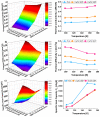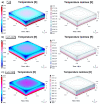Experimental and Simulation Studies of Temperature Effect on Thermophysical Properties of Graphene-Based Polylactic Acid
- PMID: 35160931
- PMCID: PMC8839625
- DOI: 10.3390/ma15030986
Experimental and Simulation Studies of Temperature Effect on Thermophysical Properties of Graphene-Based Polylactic Acid
Abstract
Overheating effect is a crucial issue in different fields. Thermally conductive polymer-based heat sinks, with lightweight and moldability features as well as high-performance and reliability, are promising candidates in solving such inconvenience. The present work deals with the experimental evaluation of the temperature effect on the thermophysical properties of nanocomposites made with polylactic acid (PLA) reinforced with two different weight percentages (3 and 6 wt%) of graphene nanoplatelets (GNPs). Thermal conductivity and diffusivity, as well as specific heat capacity, are measured in the temperature range between 298.15 and 373.15 K. At the lowest temperature (298.15 K), an improvement of 171% is observed for the thermal conductivity compared to the unfilled matrix due to the addition of 6 wt% of GNPs, whereas at the highest temperature (372.15 K) such enhancement is about of 155%. Some of the most important mechanical properties, mainly hardness and Young's modulus, maximum flexural stress, and tangent modulus of elasticity, are also evaluated as a function of the GNPs content. Moreover, thermal simulations based on the finite element method (FEM) have been carried out to predict the thermal performance of the investigated nanocomposites in view of their practical use in thermal applications. Results seem quite suitable in this regard.
Keywords: biodegradable polymers; graphene nanoplatelets; multiphysics simulations; nanocomposites; thermal transport properties; thermophysical properties.
Conflict of interest statement
The authors declare no conflict of interest.
Figures















References
-
- Krzysztof P., Njuguna J. Thermal Degradation of Polymeric Materials. iSmithers Rapra Publishing; Schrewsbury, UK: 2005.
-
- Ma H., Gao B., Wang M., Yuan Z., Shen J., Zhao J., Feng Y. Strategies for enhancing thermal conductivity of polymer-based thermal interface materials: A review. J. Mater. Sci. 2021;56:1064–1086. doi: 10.1007/s10853-020-05279-x. - DOI
-
- Lin Y., Jia Y., Alva G., Fang G. Review on thermal conductivity enhancement, thermal properties and applications of phase change materials in thermal energy storage. Renew. Sustain. Energy Rev. 2018;82:2730–2742. doi: 10.1016/j.rser.2017.10.002. - DOI
-
- Huang C., Qian X., Yang R. Thermal conductivity of polymers and polymer nanocomposites. Mater. Sci. Eng. R Rep. 2018;132:1–22. doi: 10.1016/j.mser.2018.06.002. - DOI
Grants and funding
LinkOut - more resources
Full Text Sources

